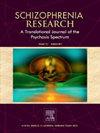精神疾病中疲劳的患病率和相关性:一项系统综述和荟萃分析
IF 3.6
2区 医学
Q1 PSYCHIATRY
引用次数: 0
摘要
人们对精神疾病患者疲劳的兴趣越来越大。本系统综述和荟萃分析回顾了有关成人精神病患者疲劳患病率及相关因素的证据。方法系统检索sembase、PsycINFO、Medline和CINAHL在1946年1月至2023年10月9日期间发表的英文论文。纳入标准为确认ICD11或DSM5诊断为精神障碍的成人(≥18岁)“疲劳”。使用JBI和Newcastle-Ottawa量表评估偏倚风险。使用随机效应模型计算95% CI的疲劳合并比例。采用Cochran's Q和I2统计量评估异质性,并采用Egger's检验检验发表偏倚。结果共有57篇文章符合纳入标准,7篇文章(n = 1161名受试者)被纳入疲劳meta分析。疲劳患病率为55% (95% CI: 37 ~ 71%, I2 = 94%)。使用有效量表(n = 711名参与者)对6项研究进行敏感性分析,发现疲劳比例为59% (95% CI: 41-76, I2 = 93%)。18项研究(n = 4569名参与者)被纳入一项分析,探讨抗精神病药物相关疲劳的患病率,这是20.5% (95% CI: 11 - 34%)。我们发现,在使用有效量表的研究(27%,95% CI: 14-46, k = 7)和使用临床访谈的研究(17%,95% CI: 7 - 35%, k = 11) p = 0.302之间,抗精神病药物相关疲劳无显著差异。安·艾格检验未发现发表偏倚。对纳入研究的质量评估显示,16%为低偏倚风险,9%为高风险,75%为中等风险。与疲劳相关的报告包括性别、年龄、抗精神病药物、痛苦和抑郁、睡眠和一些阴性症状。结论我们的研究表明,大多数精神病患者都有疲劳症状。抗精神病药物、性别和功能可能会导致疲劳症状,但需要进一步的研究。本文章由计算机程序翻译,如有差异,请以英文原文为准。
Prevalence and associations of fatigue in psychosis: A systematic review and meta-analysis
Background
There is increasing interest in fatigue in people with psychotic illnesses. This systematic review and meta-analysis reviewed the evidence concerning the prevalence of fatigue and associated factors in adults with psychotic illnesses.
Methods
Embase, PsycINFO, Medline and CINAHL were systematically searched for articles in English published between January 1946 to 9 October 2023. Inclusion criteria was ‘fatigue’ in adults (≥18 years old) with a confirmed ICD11 or DSM5 diagnosis of a psychotic disorder. Risk of bias was assessed with the JBI and the Newcastle-Ottawa Scale. Pooled proportions for fatigue with 95 % CI were calculated using random effects models. Heterogeneity was assessed using Cochran's Q and I2 statistic and Egger's tests were conducted for publication bias.
Results
A total of 57 articles met the inclusion criteria and 7 articles (n = 1161 participants) were included for the meta-analysis of fatigue. Fatigue prevalence was 55 % (95 % CI: 37–71 %, I2 = 94 %). A sensitivity analysis of the 6 studies using a valid scale (n = 711 participants) found a fatigue proportion of 59 % (95 % CI: 41–76, I2 = 93 %). Eighteen studies (n = 4569 participants) were included for an analysis exploring the prevalence of antipsychotic-related fatigue, which was 20.5 % (95 % CI: 11–34 %). We found no significant difference in antipsychotic-related fatigue between studies using a valid scale (27 %, 95 % CI: 14–46, k = 7) and studies using a clinical interview (17 %, 95 % CI: 7–35 %, k = 11) p = 0.302. An Egger's test indicated no publication bias. Quality assessments for included studies revealed that 16 % were at low risk of bias, 9 % at high risk and 75 % at moderate risk. Reported associations with fatigue included sex, age, antipsychotics, distress and depression, sleep, and some negative symptoms.
Conclusions
Our study revealed that a majority of people with psychosis experience fatigue. Antipsychotics, sex, and functioning may contribute to tiredness symptoms, but further research is needed.
求助全文
通过发布文献求助,成功后即可免费获取论文全文。
去求助
来源期刊

Schizophrenia Research
医学-精神病学
CiteScore
7.50
自引率
8.90%
发文量
429
审稿时长
10.2 weeks
期刊介绍:
As official journal of the Schizophrenia International Research Society (SIRS) Schizophrenia Research is THE journal of choice for international researchers and clinicians to share their work with the global schizophrenia research community. More than 6000 institutes have online or print (or both) access to this journal - the largest specialist journal in the field, with the largest readership!
Schizophrenia Research''s time to first decision is as fast as 6 weeks and its publishing speed is as fast as 4 weeks until online publication (corrected proof/Article in Press) after acceptance and 14 weeks from acceptance until publication in a printed issue.
The journal publishes novel papers that really contribute to understanding the biology and treatment of schizophrenic disorders; Schizophrenia Research brings together biological, clinical and psychological research in order to stimulate the synthesis of findings from all disciplines involved in improving patient outcomes in schizophrenia.
 求助内容:
求助内容: 应助结果提醒方式:
应助结果提醒方式:


